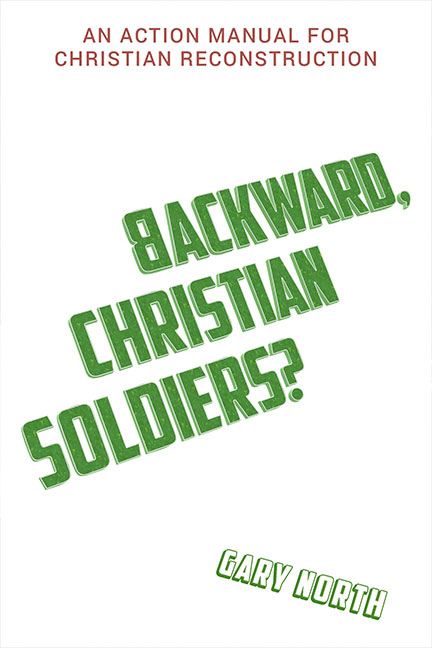
Chapter 26
Gary North
Narrated By: Alan Bailey
Book: Backward, Christian Soldiers?
Topics: Christian Life, Culture
How Much Time?
“Aim high, aim carefully, and shoot long.”
Subscribe to the Audiobook
iTunes Google Spotify RSS FeedChapter Text
It should be obvious that a suitable strategy for a marathon runner is considerably different from a sprinter’s strategy. If you have 26 miles to cover, your pace will be a lot steadier, and you will be called upon to maintain considerably greater reserves of energy. The sprinter will give a lot more attention to the crouch, the starting blocks, and the signal to start. The distance runners do not even bother to crouch; there are no starting blocks; and you never see a false start by those anticipating the starting run. It is endurance, not speed out of the blocks, that will determine the success of the marathon runner.
The Hebrews were promised a kingdom land in Canaan. Yet the promise took several centuries to come true, from Abraham’s day to Joshua’s, and the period of training involved years of captivity and four decades in the wilderness. So while their advent into the promised land was a sharp discontinuity from the point of view of the Canaanites of Moses’ day, from the point of view of the Hebrews, it was a long-term process. The foundations had been laid between Abraham’s era and Joshua’s; the seemingly rapid completion of the conquest was possible only because of the centuries of theological, ecclesiastical, and institutional investment that had preceded it.
The kind of institution a person or a group builds depends upon their estimation of the capital, skills, and time available to them. If they are convinced that there is insufficient time to bring the project to its completion, then they have the architect redesign the plans. Similarly, if they are convinced that the skills or the capital available are minimal, they will design the plans accordingly. It is senseless to start construction without estimating in advance the likelihood of its being possible to bring the project to completion (Luke 14:28-30). Furthermore, if a person thinks the structure will be in service for 50 years, he will use one set of construction materials. If he expects it to be in service for several centuries, he will select a different quality of building materials.
Does it make sense to criticize the short-run builder? It depends. The British in the early nineteenth century built their rails with the best, most expensive steel available. It consumed large quantities of financial capital. Americans built their railroads using cheaper materials that were only expected to last a couple of decades. Meanwhile, tremendous gains were made in metallurgy, and by the time the American rails were worn out, they could be replaced with far better rails than the British possessed, and at a far lower expenditure of capital. Throughout the intervening years, the builders had the extra capital to use for other purposes. They “built cheap,” and let technology come up with the better product later on. The same thing has happened in our era with computer technology. It is not sensible to “buy ahead” when you buy a computer; increased needs in the future should be purchased in the future, when prices will be far lower and performance will be greater.
But what about the long-run builder? Is he foolish? It depends on whether or not we really have a lot of time remaining to us – collectively, as a race; nationally; or geographically, where we are building our structures. Maybe there were Canaanites who went to considerable expense just prior to the exodus to build family estates that would last 500 years. Not too smart, in retrospect; they were just increasing the capital value of the Hebrews’ property. If we expend huge quantities of long-term capital, and discover that it is blown away by short-term forces of history, then we have wasted our capital. However, if we blow away our capital on short-run projects, only to discover that we have run out of money a long time before the end appears, then we have also wasted our resources. It is imperative, then that we make accurate assessments concerning the time remaining to us.
It should be obvious that in the twentieth century, very few Christian groups think that we have a lot of time remaining. This has drastically influenced the kinds of institutions they have/constructed, and are in the process of constructing. (Why these groups continue to encourage pension fund programs and annuities for their pastors is a mystery, but they do. Maybe – just maybe – the administrators of the funds think they can get access to the ministers’ money today, and avoid having to payoff later, in the post-rapture period. Of course, the fund managers may decide to invest the funds in terms of this operating assumption, praying fervently that Christ returns in glory before the dollar goes belly-up and the funds go bankrupt. It is my contention that a majority of pension investors and annuity holders living today will learn to their dismay that time has run out for the dollar, not the dispensation.)
In medieval times, communities built cathedrals that were expected to last for a thousand years, and some of them have. Generations of local contributors and craftsmen would add their money, goods, or services to the long-run construction project. These majestic buildings are no doubt being used today by people who do not hold dear the religious beliefs held by the builders, which is the best argument against what they did, but at the same time, these structures attest to the long-run vision they shared, their hope for the future, and their willingness to sacrifice present income for the sake of the beauty which many generations after them would enjoy. If they built their cathedrals for narrowly ecclesiastical reasons – a vision of the church and church worship-then they may have erred, for the church in our day has abandoned the kind of supernaturalism that the builders revered. However, if they built in terms of a broader-based kingdom ideal – an ideal encompassing beauty, majesty, craftsmanship, and architectural skill-then their efforts were not wasted. Of course, it seems likely that they built for both reasons, for the kingdom clearly encompasses the church as an institution, so part of their desires have been frustrated. But time frustrates almost every human vision to some extent, and theirs at least has persevered in the realm of aesthetics. Like the builders of the tabernacle, or Solomon’s temple, their efforts were later misused by evil men, but they left a heritage nonetheless.
TRACTS AND TREATISES Is it preferable to spend $10,000 on printing up a million tracts, or is it better to print up 7,500 books? Again, it depends. The tracts will not survive the test of time. The gospel is furthered in a particular era, assuming the tract is actually distributed and read. But the tract is short-lived. Its effects will be brief, except insofar as those converted by its message go on to write more tracts, or evangelize on a face-to-face basis. The printer of tracts knows that the results will be visible soon, or not at all, for a tract is like a shooting star: bright, possibly exciting, but soon dimmed.
The book producer knows that his book may stand the test of time. It may survive and become the foundation of a new movement, a new school of interpretation, the basis of a new civilization. Certainly, Augustine’s writings became just that (William Carrol Bark, Origins of the Medieval World). So did Aquinas’ books, and Calvin’s. Would they have better spent their time writing tracts alone? Would our heritage have been greater? Few people would say so today, I suspect. One thinks of Gregor Mendel, the obscure monastic, working with his peas. No one read his report on genetic variation when it was first published over a century ago in an obscure scientific journal, but his research became the basis of modern genetics a generation later. Was he wasting his time? From what he could see when he died a century ago, he might have been, but he would have been wrong.
Anyone who has looked at the library of a deceased typical pastor discovers very fast that the bulk of his library is worthless. The books on pastoral counselling, on preaching, on psychology, on church management, even on historical topics, are all too often third-rate studies by fourth-rate writers. Their books did no better than a tract, possibly not as well. If the pastor happened to be a theological liberal, and if he collected his books from 1900 to 1930, there may not be a single volume that anyone, liberal or conservative, would read today, except as an historical curiosity. Twentieth-century fundamentalism has done far better with its tracts than its books; its tracts gather converts, but its books gather dust.
One reason for this is the time perspective of modern Christianity. If the end is near, the evangelist seeks the “biggest bang for the short-term buck.” He seeks visible converts, filled pews, and an army of tract-passers. While everyone acknowledges that “Explo-72” (or some other crash-program in mass evangelism) is little more than a faded memory in the minds of most American Christians a decade later, and was never even noticed by the vast majority of American pagans in 1972, there is always hope that next year’s campaign will gain that last convert, after which Christ will return, either in judgment or secretly, before the Tribulation. The kingdom is not seen as a growing, transforming civilization, into which many are pressing to enter, but as a kind of theological spaceship, into which the remnant is pressing in order to escape some terrible cataclysm. When the last passenger is on board, it will be time for the big blast-off, leaving the world behind. The kingdom as spaceship, like the kingdom as island, or the kingdom as fortress, is a negative conception of the kingdom – a place of refuge, not a civilization for conquest.
CONCLUSION We do not know for certain when the end will come. We must be like long-distance runners who conserve their strength because they are never quite certain until the very end where the finish line is. Yet we must acknowledge that we may not slack off, for our energy is to be conserved for that final “kick” that carries us across the finish line in the lead. We dare not get too far behind. We must not plan for a victory sometime in the distant future, and then neglect the hard realities of keeping up the pace in the present. We need tracts to go with our treatises, and converts for continuity.
The sprinters of the theological world have left very little as an inheritance. Those who have planned to “evangelize Africa in a generation,” or “win the youth of the nation by 1976,” or whatever, have pursued a demonic goal – demonic because it sidetracks the construction of long-term Christian projects in favor of short-term, unrealizable, and very expensive campaigns that are, of necessity, concerned only with the surface of Christian faith and Christian culture. Better to plan for a long-term program to subdue the whole earth, generation by generation, than to squander our capital in a short-term sprint to save a remnant and then leave the world to the devil. Aim high, aim carefully, and shoot long. Time is on our side because God controls time and has given to His people all the time they need to carry out the terms of the dominion covenant. It will take time for our capital to become totally productive, like the orchard. Maybe that is one reason why God forbids us to eat the produce of the orchard until its fifth year (Lev. 19:23-25): a reminder that we have plenty of time left to enjoy the fruit of our labor. Therefore, get to work planting, today.
